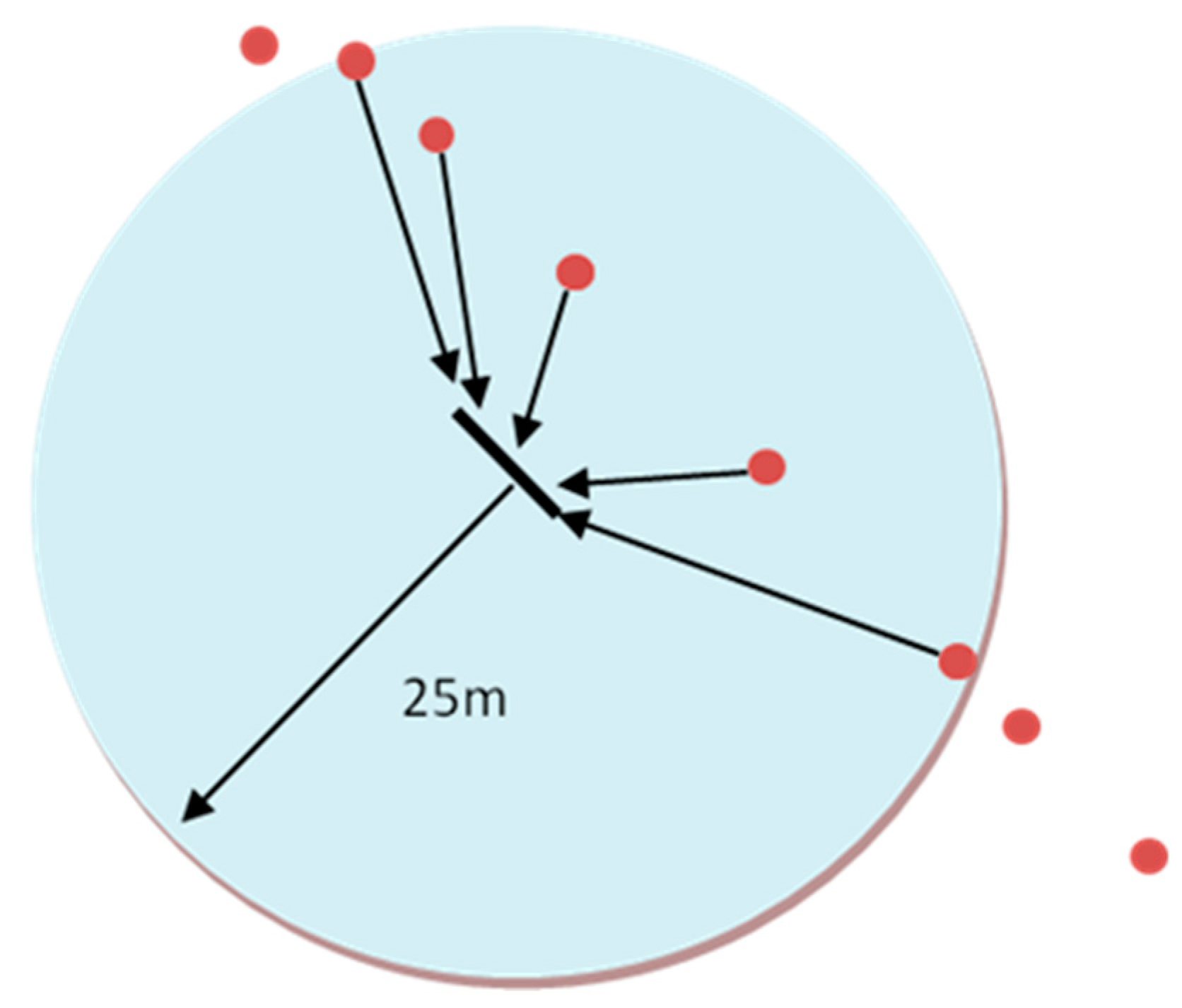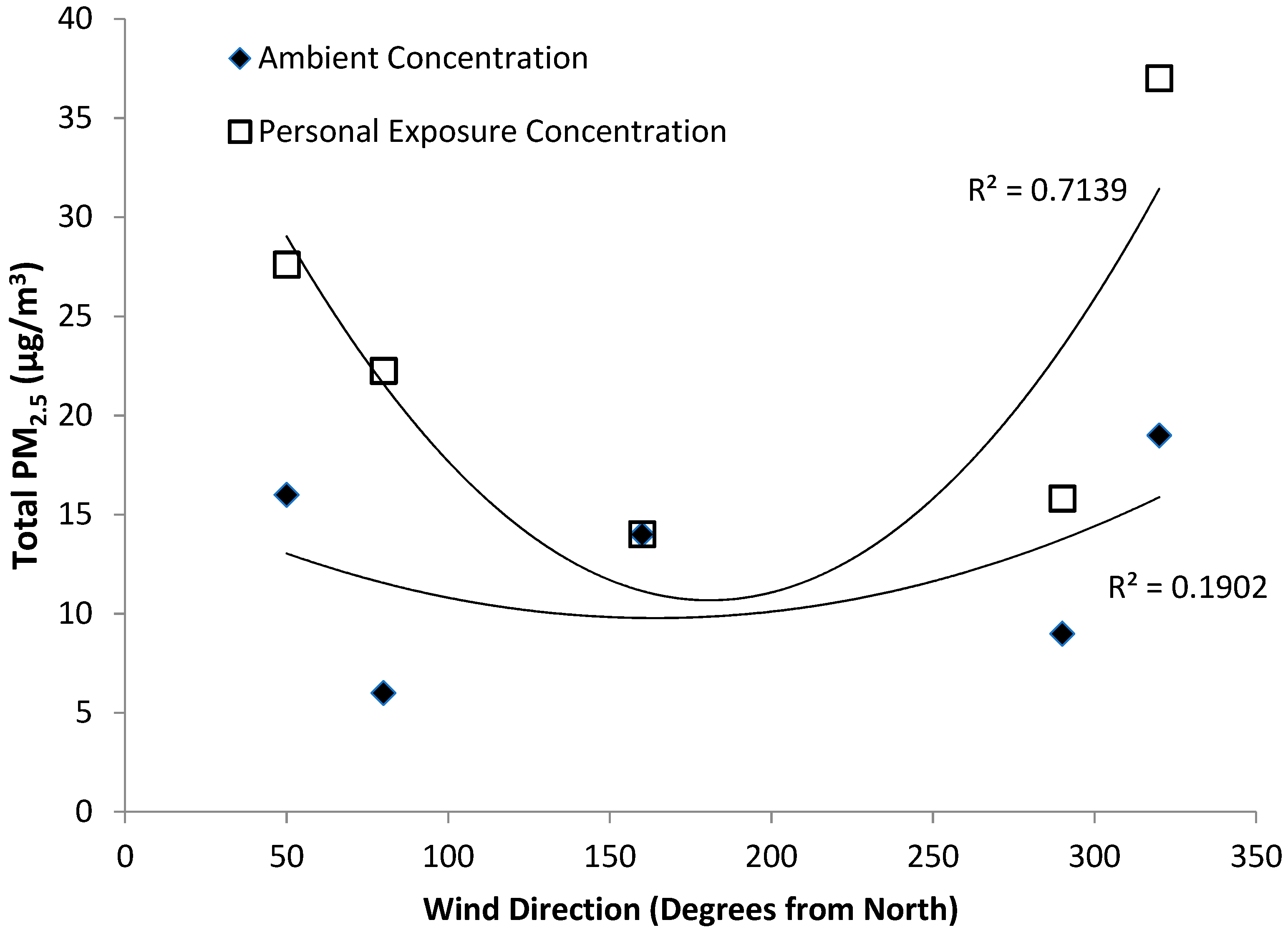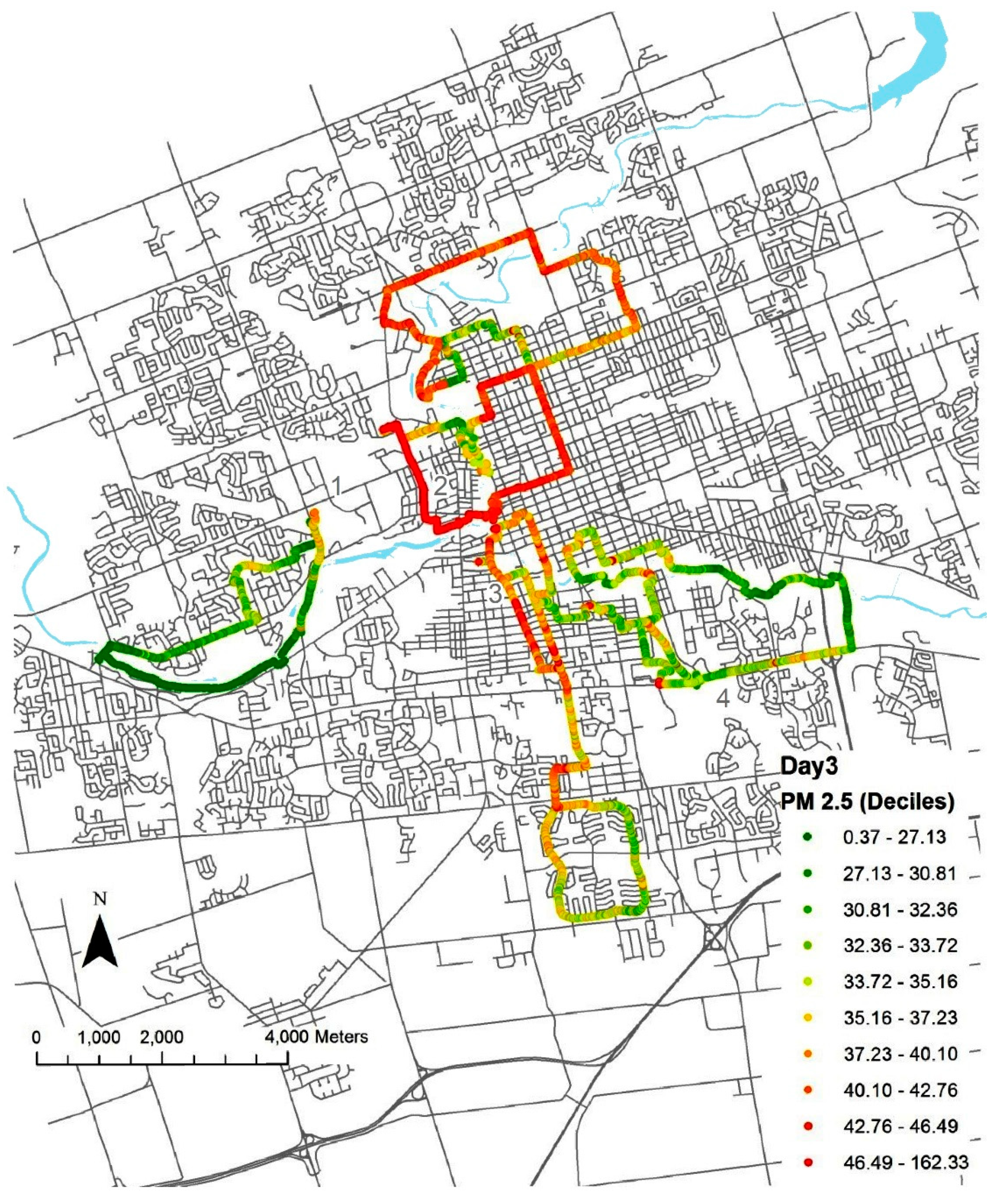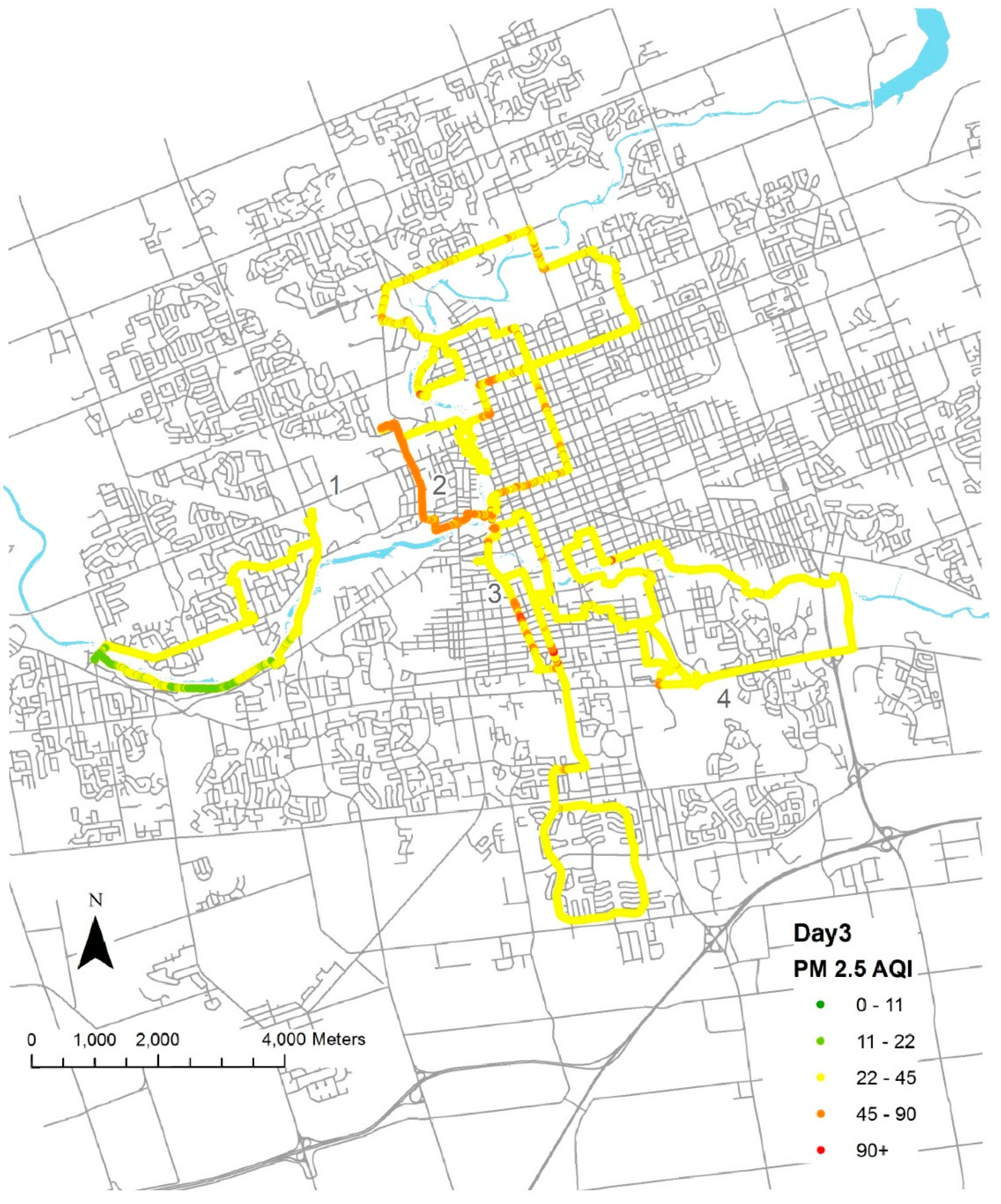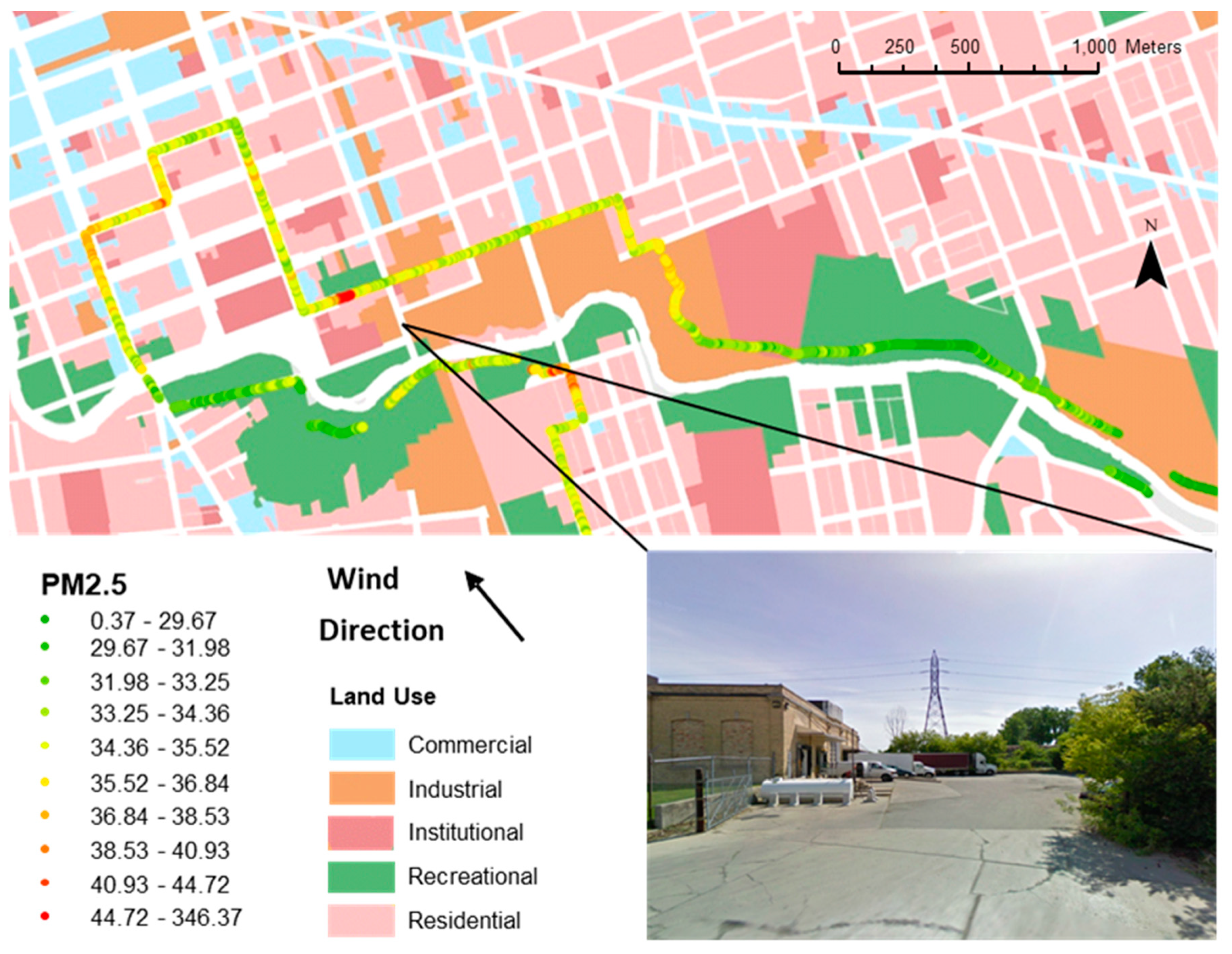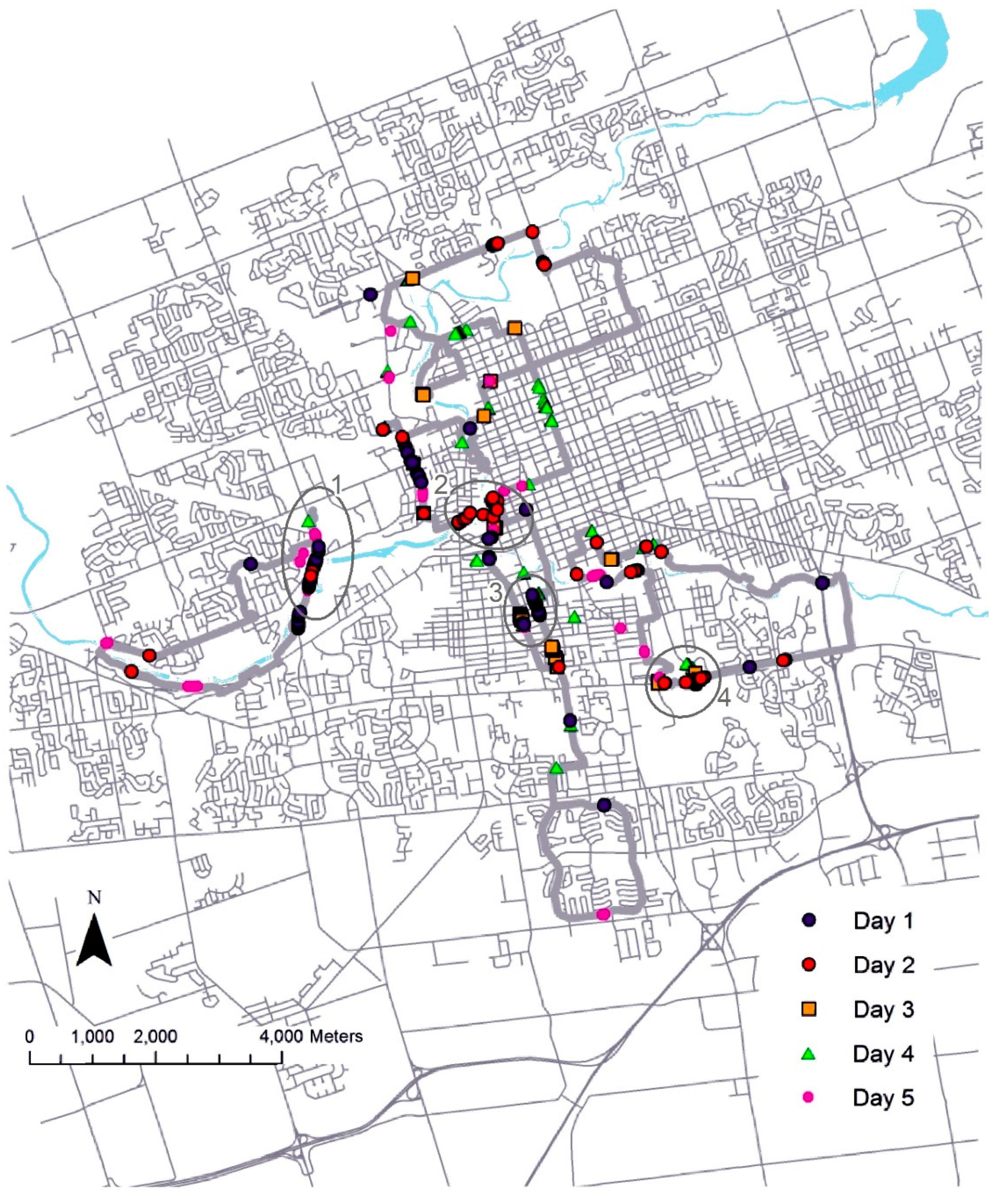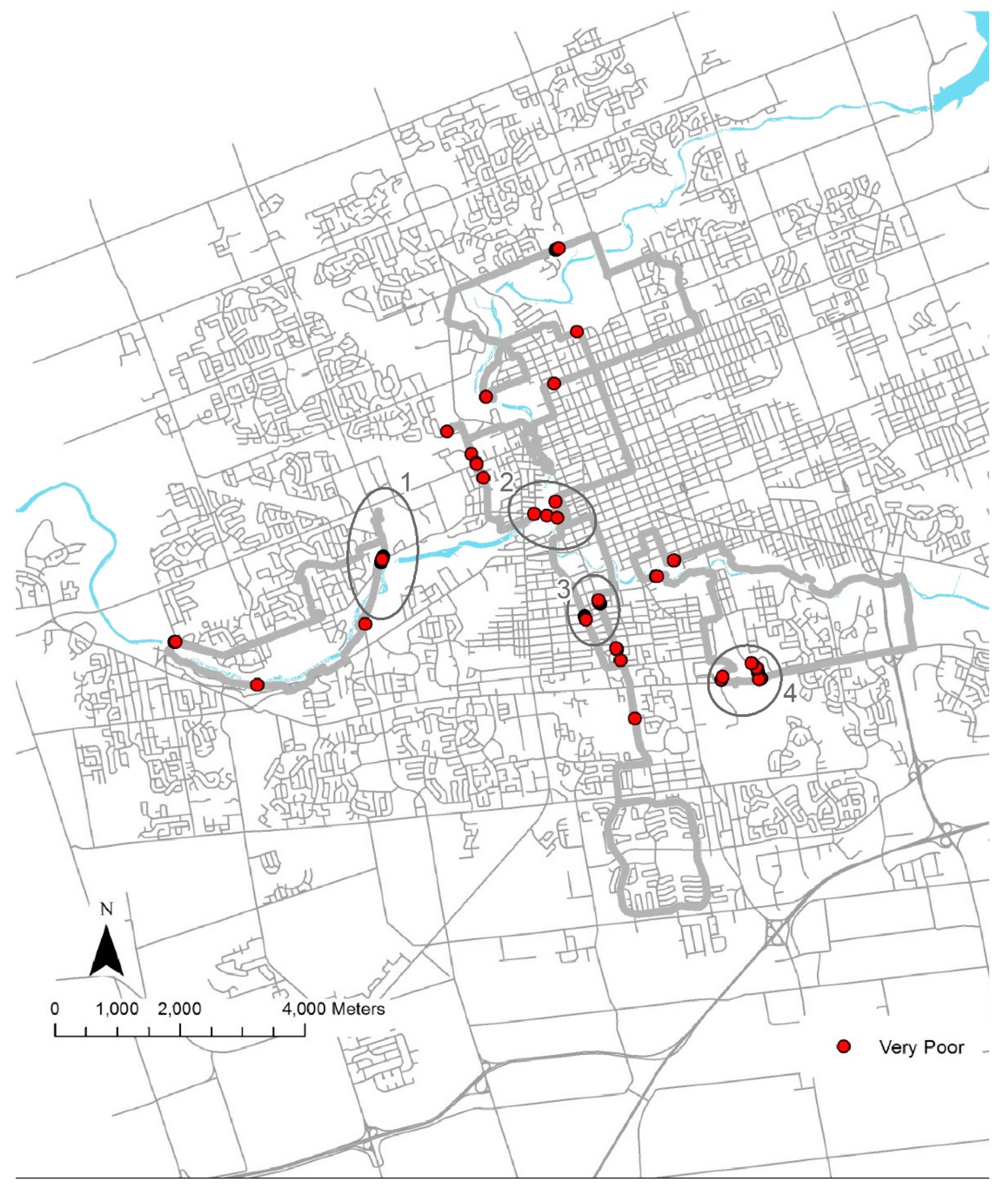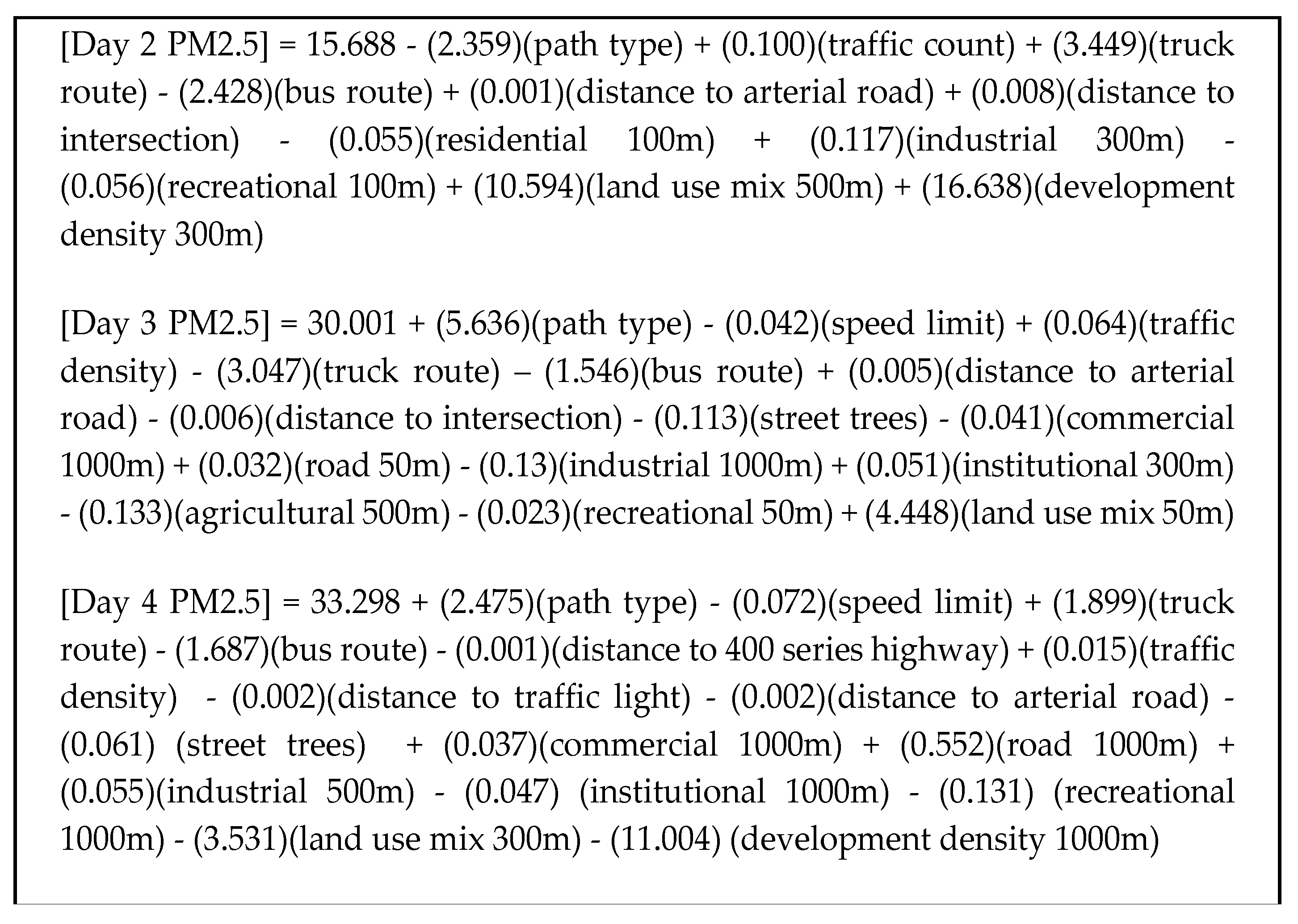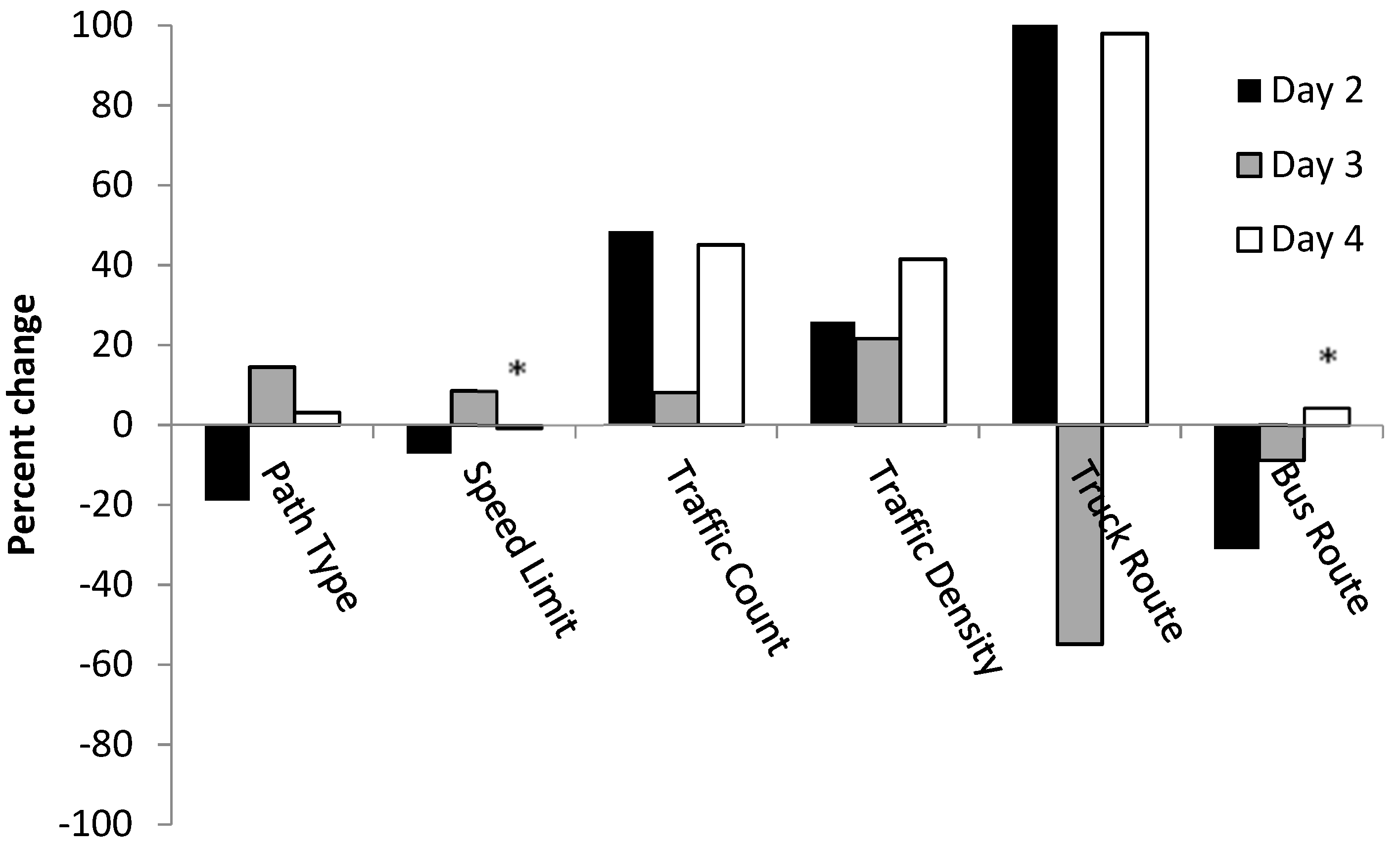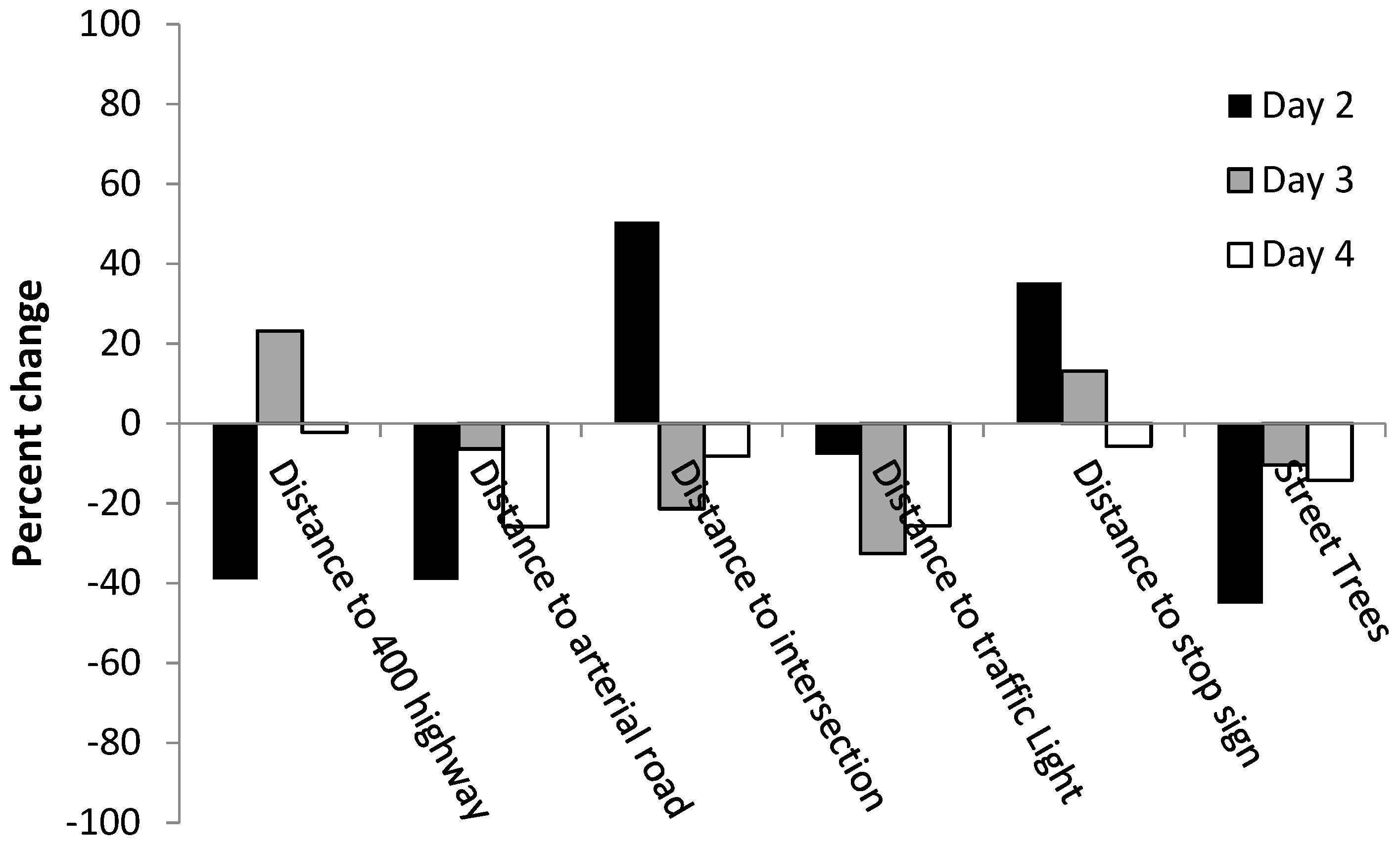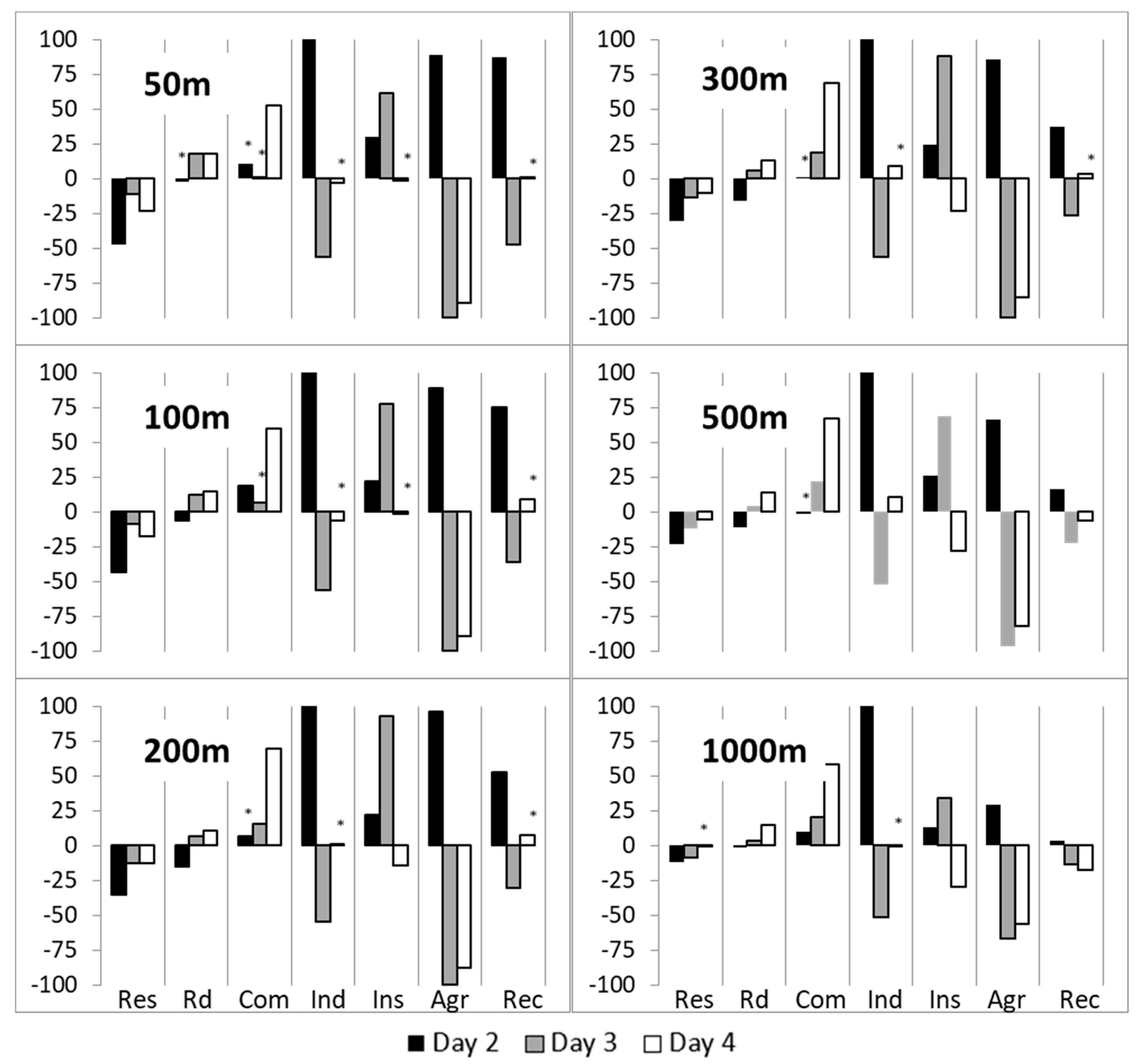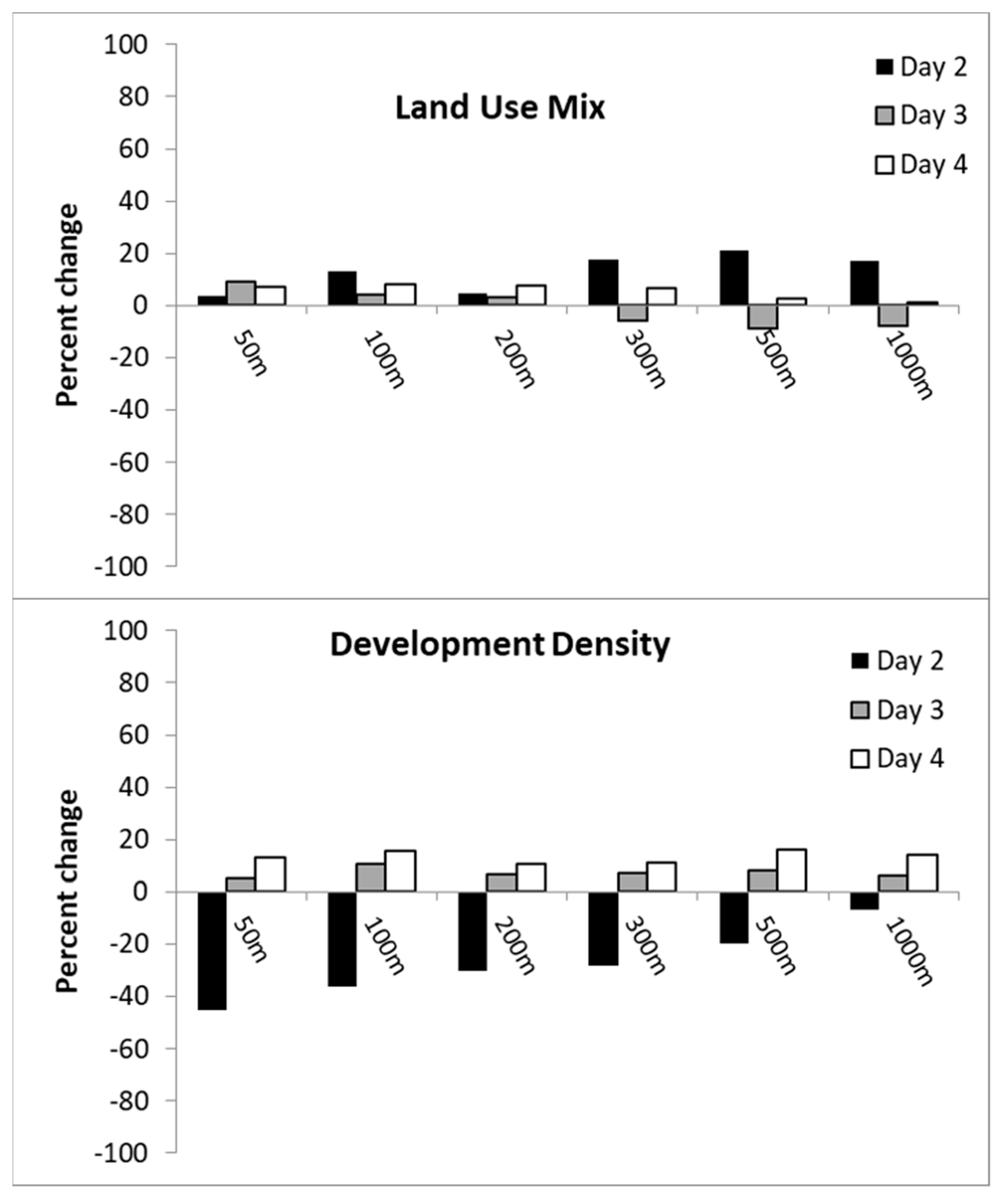1. Introduction
Cycling is becoming an increasingly popular commuting choice for North Americans [
1,
2]. Many cyclists and promoters of ‘active transport’ perceive cycling to be the healthier commute option compared to motorized transport [
3,
4,
5,
6]. However, when in close proximity to vehicular traffic, cyclists may be exposed to levels of air pollution (e.g., particulate matter ‘PM
2.5’), which are potentially hazardous to their health [
7,
8]. PM
2.5 is of special concern to cyclists as it is considered a respirable fraction since it can penetrate deeper into the lungs than larger particulates and thus capable of damaging the gas exchange surface directly [
9]. Exposure is compounded with increased breathing rate and intensity [
10] and extra time spent commuting compared to those who travel by motor vehicles. The natural environment, especially meteorological conditions, is known to significantly contribute to variation in PM
2.5 concentration. Specifically, active personal measurements of PM
2.5 increase with temperature but are not influenced by precipitation [
11]. Wind has also been found to significantly reduce PM
2.5 measurements [
12,
13,
14,
15], accounting for 18% of PM
2.5 variation in one study [
16], or had no effect [
11,
17]. A vertical gradient in PM
2.5 distribution exists for both intraurban elevation [
18] as well as on the microscale, requiring personal exposure equipment to sample air near the breathing zone for accurate measurements [
12]. Although meteorological parameters have been shown to influence dispersion, one study [
19] could not find any significant influence on the elemental composition of PM
2.5.
Although much of the ambient PM
2.5 is a result of long distance transport [
6] of often unknown sources, the built environment can generate or influence the distribution of PM
2.5 in local scales, especially in urban centres. Mutually inclusive categories of the built environment known to influence PM
2.5 concentrations include infrastructure responsible for traffic, urban form, and land use. In Toronto, motor vehicle-related emissions including road salt were estimated to be responsible for about 40% of observed PM
2.5 [
20]. Daily PM
2.5 measurements were influenced by distance from arterial roads [
18] with a modest, but significant gradient based upon traffic volumes [
21] There is, however, disagreement over how much traffic accounts for differences in personal exposure to PM
2.5. Increased particulate readings were observed, but not quantified, around traffic-lighted intersections attributing this change to emissions occurring when vehicles slow and accelerate [
22] Urban form, consisting of building configurations and road layout, has also been shown to influence PM
2.5 distribution. The street canyon effect, where the shape and height of buildings and proximity to the road influences airflow, has been shown to: (1) have an effect on PM
2.5 readings depending on the direction of wind [
15], (2) influence daily PM
2.5 measurements in Hong Kong [
23] and (3) have no effect in London, UK [
24]. Land use has not often been correlated with personal exposure measurements of PM
2.5 and there have been conflicting reports of their influence on intraurban PM
2.5 variability. High resolution personal exposure to PM
3, a particulate matter fraction very similar to PM
2.5, was found to be fairly homogenous across land use categories over a 20 km bicycle route in Vancouver, Canada [
11]. Similarly, distance from industrial PM
2.5 point source emissions did not predict daily sum PM
2.5 counts [
18]. In contrast, daily PM
2.5 measurements in Hong Kong were found to vary depending on the sample location’s predominant land use, with the lowest found in industrial, moderate in commercial and highest in residential; however statistical analyses were not conducted to delineate the influence of individual land uses potentially nullifying the significance of land use as a predictor of PM
2.5 distribution.
Very few studies have examined personal exposure to air pollution of cyclists, with the majority of previous research taking place in European towns and cities. Even fewer studies attempt to account for the specific environmental elements that contribute to the variation in pollutants such as PM
2.5. To our knowledge, no previous study has assessed both elements of the natural environment and built environment for the relative importance of these factors in accounting for variability in PM
2.5 personal exposure to cyclists [
25]. In an attempt to fill gaps in knowledge, this study examines environmental influences on personal exposure to PM
2.5 among cyclists in London, Ontario, a mid-sized Canadian city with a population of 383,822 in 2016 [
26]. Commuting cyclists are generally unable to complete their entire journeys along segregated bike paths (away from roads) and often must navigate a variety of land uses, built environments and urban forms, each with different potential for air pollution concentrations. Previous literature has found considerable variation and conflicting results for predictors of personal exposure of cyclists to PM
2.5, suggesting that the conclusions of personal monitoring studies cannot be uncritically transferred to different geographical locations [
27]. This study aims to map and identify the urban characteristics of PM
2.5 hotspots, defined here in two ways: as the top 1% of readings, and alternatively as any measurements within the highest health bracket determined by the Ontario Ministry of the Environment (PM
2.5 > 91 μg/m
3). The larger purpose of the study is to create a predictive model for PM
2.5 exposure along a bicycle path by incorporating the highest correlated elements into a linear regression model in order to provide evidence for future route planning or route modification.
The elements of the built environment examined in this study were selected based upon their known contribution to intra-urban PM
2.5 variability from previous research. Traffic-related variables including path type, speed limit, traffic, and distances to various traffic-related elements (nearest arterial road, intersection, etc.) were selected as vehicle emissions have been shown to contain PM
2.5 [
20]. Truck and bus routes were also selected as PM
2.5 has been shown to be an especially good proxy for diesel engine emissions [
12]. Street trees have been shown to reduce ultrafine particle (UFP) from roadways [
28] but have not been examined for their role in the PM
2.5 distribution and are thus included in this analysis. Land use and measures of land use mix were also considered as they have been shown to influence personal exposure to PM
2.5 [
13]. Buffer distances for land use variables were based on previous linear regression models for PM
2.5 [
17] as no a priori known gradient for PM
2.5 concentration decay has been observed from major roads [
29].
This case study uses a high resolution PM2.5 monitor in combination with a portable GPS tracker to provide a spatial account of the specific environmental elements that contribute to the variation in personal exposure to PM2.5 of commuting cyclists. Specifically, this case study aims to locate PM2.5 ‘hotspots’ along bicycle commuting paths and to assess relationships between characteristics of the natural and built environment and the variability in cyclists’ PM2.5 personal exposure. A better understanding of environmental correlates with air pollution exposures may help municipal policymakers, planners, and engineers develop more effective policies and/or infrastructural interventions for mitigating negative health impacts of air pollution in support of healthy, physically active modes of transportation such as cycling.
4. Discussion
This research assessed which elements of the natural and built environment contribute to the variability found in personal exposure concentrations of PM2.5 while cycling during the morning commute in London, Ontario.
4.1. Correlation between Meteorological Factors and Personal Exposure to PM2.5
The low correlation between temperature, relative humidity, and wind speed with mean daily personal exposure to PM
2.5 is likely due to the minimal variation in these predictor variables throughout the study period. In agreement, these meteorological variables have been shown to exert mixed or minimal influence on PM
2.5 exposure in the literature [
11,
13]. One of the most interesting correlations found in this analysis was between wind direction and PM
2.5 concentrations, with wind blowing from southerly directions significantly increasing personal exposure to PM
2.5 along the bicycle path. It is not possible in this study to delineate the influence of the Macdonald-Cartier Freeway (highway 401), which is one of the busiest highway in North America and located immediately south of the study area, from the more regional distribution of major polluters including the many coal power plants located south in the Midwestern United States; however, literature exists supporting the latter [
20]. The effect is much more pronounced with personal exposure measurements than with ambient concentrations, suggesting that ambient monitors underestimate the magnitude of the influence of wind direction. One policy that may be employed to mitigate this discrepancy would be to issue a warning on days with high ambient pollution and wind from the south for vulnerable populations considering outdoor physical activity.
4.2. Hotspots
Previous research concluded that PM
2.5 hotspots are chance occurrences [
13]; however, our study has found consistency between days in several geographic locations. Specifically, hotspots were found in four areas: the busiest bridge in London, the downtown urban core, and two sites which were undergoing road construction during the week of the study. Traffic is known to influence PM
2.5 but it is not known what, if any, additional factors a bridge may have over a land intersection with similar traffic volume. It does suggest that there is merit in separate bicycle bridges which exist in London, Ontario, but were unfortunately not part of this study. The second major hotspot is the urban core, which is also the site of high traffic levels and a high concentration of non-residential activities. It is also possible that an “urban canyon effect” is present, whereby generally poor airflow due to the higher density of buildings may be partly causing pollutants to be trapped at street level; however, this is normally a phenomenon observed in much more highly developed cities such as Hong Kong [
23]. Finally, previous research found similar results for construction sites and personal exposure to PM
10 [
11]. A simple policy suggestion that can minimize exposure to PM
2.5 for cyclists who are concerned about air pollution (i.e., elderly or asthmatics) would be to use signage to temporarily detour bicycle routes around the vicinity of construction sites.
4.3. Correlation between Elements of the Environment and Personal Exposure to PM2.5
Many elements of the built environment were significantly correlated with PM
2.5 exposure across all study days; however, most showed mixed positive and negative relationships. The mixed correlation found between concentrations of PM
2.5 and the road type (pathway or on road) and between the regions of high concentrations and low concentrations is not in agreement with previous research with cyclist commuters which found significantly greater exposure levels of both benzene and general particulate matter for those who traveled by road compared to path [
41]. It is thus possible that PM
2.5 is less influenced by the cyclists’ position relative to traffic at very short distances compared to other air pollutants. This is also evident in the mixed correlations with both bus and truck routes. Bus routes possibly due to London’s public transit authority incorporating hybrid electric buses into the fleet which may have reduced PM
2.5 concentrations around the cyclists. A statistically higher portion of the cycled network in the 20% highest PM
2.5 concentration category was designated as truck routes compared to the remainder of the cycled network on two of the three days. This suggests the possibility that single events, such as a cyclist following a truck, may significantly influence personal exposure to PM
2.5. However, as these do not occur consistently, there is low merit avoiding these roads designated for either bus or truck based upon PM
2.5 measurements in this study.
Traffic has been cited in the literature as a determinant of PM
2.5 exposure; however, this relationship is far from conclusively established. For example, Thai, McKendry and Brauer [
11] found little influence of traffic on PM
2.5 personal exposure to cyclists but did find a relationship with ultrafine particles. Our research supports the connection, with several predictors for traffic in our study being significantly correlated with personal exposure to PM
2.5. Furthermore, correlations were consistently higher in the regions with the highest pollution concentrations using both traffic count and traffic density measures. Traffic density was one of the strongest overall determinants for PM
2.5, doubling the correlation found with traffic counts. This emphasizes the importance of spatial considerations, as air pollution dispersion is not confined to street segments. The negative correlation between PM
2.5 and variables such as the distance to nearest 400 series highway, arterial roads, intersection, traffic Light, and stop sign on most study days suggests a strong influence of traffic, especially areas where traffic accelerates and decelerates. Specifically, the lower distance to arterials and to traffic lights in the regions with the highest pollution on all days suggests the particular importance of these two factors when planning future bike routes or route designations. Road surface area was also strongly correlated to personal exposure to fine particulate matter, especially on days with higher ambient PM
2.5. This possibly reflects the phenomena of slower traffic resulting from the increased area for vehicles, compounding the emissions by having more accelerations and decelerations. Planners of future bicycle paths or designations should, therefore, whenever possible, avoid sources where traffic accelerates and decelerates, especially minimizing the distance to the nearest traffic light, which was the strongest predictor variable. Furthermore, cycling routes should be segregated, if possible, 100 m from arterial roads, and avoid commercial and industrial sites.
The negative correlation between the number of street trees located within 25 m of the path with personal exposure to PM2.5 and the evidence that route segments which contain more street trees are also those with the lowest air pollution concentration suggest an important role for street trees in minimizing exposure. The relationship was most profound on the days with the highest ambient measurements, day 3 and 4, signifying that trees may play an especially important role in reducing street-level PM2.5 during days that exceed the provincial health guidelines for healthy activity. The similar trend in recreational land use on days with higher pollution levels further supports this conclusion. It should be cautioned that it is not known whether trees reduce PM2.5 concentrations for cyclists, or if trees are preferentially planted (or are more likely to survive) in microenvironments with low PM2.5.
Other land use determinants for air pollution are generally mixed in their effect. The low fine particulate matter correlation and concentration in areas with high residential zoning, especially on days with low ambient pollution concentration, indicate that PM2.5 sources from the home such as cooking or smoking generally do not have a major influence on personal exposure to cyclists. It is also highly probable that the presence of residential zoning infers the absence of another potentially higher polluting land use. The correlation between commercial zoning and high PM2.5 concentrations on days with moderate and high ambient levels signifies that commercial activity has a role in the generation of PM2.5. This conclusion is strengthened by the similar pattern found with development density. PM2.5 concentrations were positively correlated to industrial land use area except on the day with the highest ambient PM2.5 concentration, where the influence was lower. This is possibly due to regional forces washing out the influence of local industrial PM2.5 sources. Institutional and agricultural land uses appeared to have a mixed and weak influence on PM2.5 concentrations possibly due to the generally low occurrences of these land uses along bicycle paths. Similarly, land use mix and speed limits were two predictor variables that showed mixed relationships with PM2.5 concentration with no apparent trend. To sum: bicycle routes should, if possible, travel through residential and recreational land uses avoiding traffic lights and arterial roads. Industrial sites should be avoided on low pollution days, and nearby street trees may reduce personal exposure to air pollution.
Caution must be exercised when interpreting these results, as determinants of air pollution are often linked with the interactions between them still not well understood. The correlation portion of this analysis assumed a linear relationship between elements of the environment and exposure to PM2.5, which, despite being a traditional statistical analysis, may not reflect reality. For example, increased road surface area could amplify PM2.5 release creating an exponential relationship from feedback caused by decreased speed due to increased traffic, or street trees may only influence PM2.5 concentrations when they reach a critical density. The high variability between days in the linear regression model suggests that elements of the natural environment must be incorporated into a final model, which was unfortunately not possible in this analysis due to the low number of sample days. The analysis comparing the regions with the highest 20% to the lowest 80% PM2.5 concentrations was highly susceptible to unpredictable variations in traffic, such as the cyclist following a bus or truck, and construction; however, our multi-day analysis helps minimize this concern. These data must be interpreted with caution because our measures for wind speed (and direction) were taken at one station in the city rather than the exact same location where personal PM2.5 exposure measures were recorded.
4.4. Implications for Public Health and Policy
Our research has found many incidences of personal exposure to PM2.5 exceeding the Ontario Ministry of Environment’s guidelines for healthy activity. Mitigation strategies aimed at balancing the health benefits of cycling with the environmental exposure to pollutants can take on two forms: behavioural modification and infrastructure modification. This research has provided evidence supporting both efforts. Infrastructure changes are limited by the need to connect people to where they want to go, thus planning decisions are constrained to elements amenable to change. Cycle paths can be created or designated to minimize pollution exposure using models which consider the environmental factors that were revealed here to be correlated with personal exposure to PM2.5, and are found in the zones with the highest observed concentrations. Alternative routes may also be made available to vulnerable populations to minimize exposure. A linear regression model which incorporates both elements of the natural and built environment can be used for planning future routes though it should be field tested in the new locale to ensure transferability. Although we have shown here that pollution concentration varies significantly between and within routes, the question remains as to the medical relevance of this difference; i.e., how exposure to different pollution concentrations can differentially damage one’s health. This study has employed novel tools including combining a high resolution personal monitor with a portable GPS device, and outlined methodologies for incorporating factors of the natural and built environment into a greater understanding of pollution exposure during the cycling adults. This research ultimately supports the important role of commuter agency and planning in the creation of healthy microenvironments. Future research should combine this novel instrumentation and spatial analysis techniques with health outcomes to provide a link which can be used to strengthen mitigation strategies. This case study should be repeated using different technical specifications (e.g., route selection, survey timing, proximity defined by different buffer sizes and types, etc.) and by applying different spatial and non-spatial modeling approaches.
